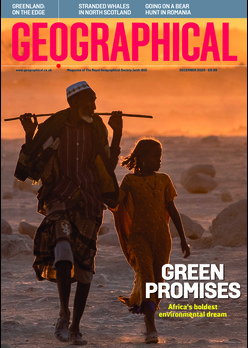
Geologist Marie Busfield shares with Bryony Cottam how to make the most out of every expedition – from Namibia to Death Valley
Some 700 million years ago, the whole planet may have been trapped in ice. Evidence of a ‘Snowball Earth’ has been found in some of the warmest parts of the world, where the rocks have preserved signs of ancient glacial activity. It’s this theory that led Marie Busfield, a geologist at Aberystwyth University, to the arid scrublands of northern Namibia.
It’s a curious corner of the world, she says, far from the beaten tourist trail and yet beautiful in its own way. The wildlife and landscape, along with its many acacia trees, have certainly left a lasting impression. ‘There’s one tree called wag-’n-bietjie in Afrikaans, which means, ‘wait a minute’, because it has these hook-shaped thorns that catch in skin, clothes and fur. They’re very good at catching geologists, too.’
Travel, says Busfield, is obviously a great perk of being a geologist. ‘It’s taken me all over the world, and probably to parts of the world that I never would have experienced otherwise — such as Namibia. I had no reason to be there beyond the rocks.’ While there are lots of geologically interesting sites that receive plenty of visitors, Busfield says that the best rocks aren’t necessarily in places with a lot of tourism. It’s one of the reasons she thinks geo-tourism should, on the whole, be promoted.
Marie’s expedition insights
• Respect and protect the local landscape
• Make connections with local people
• Plan-in rest days, travel is exhausting
‘If you look at places like the Grand Canyon today, it is absolutely overrun by tourists — and I say that as someone who’s been there twice as a tourist myself.’ Encouraging travellers to visit other, lesser-known but equally fascinating sites could take the pressure off some of the busiest, while bringing the benefits of tourism to places that don’t have many other resources to rely on. At the same time, Busfield says we should all be aware of local rules – such as bans on removing pebbles from UK beaches – that are there to protect the landscape. ‘I think people assume that rocks are robust and can withstand anything. A little bit of care and attention, and having respect for the land, is a good idea wherever you go.’
Busfield’s own interest in ancient ice ages has taken her to many places that, today, are hot and sunny – including Death Valley – but which many years ago were covered in ice. Once in the field, she studies how the landscapes have been shaped by long-lost glaciers and ice sheets, trying to work out how our world was formed. ‘It’s essentially like a giant puzzle,’ she says. ‘You can see history written in the rocks, and you can understand how places have changed over really long time scales. It’s exciting.’
Sometimes, her fieldwork is made more challenging by the extreme environments in which she works. The big swings in temperature between night and day, which are common in many arid environments, can be a shock to the system, ‘particularly if you’re camping’, Busfield adds. Then there’s the more dangerous wildlife, such as snakes and scorpions. ‘Once we found ourselves in a forest, face-to- face with a giant moose.’

While she often travels with someone familiar with the location, Busfield says it’s always good practice to work and make connections with local people. ‘It’s a good idea anyway; they can usually inform you about the place.
But it’s also much better than doing “helicopter science” [where researchers from higher income countries carry out fieldwork in less-privileged areas with little to no involvement of local communities or scientists].’
Another important, but sometimes overlooked, element of any fieldwork trip is planned rest days. Busfield says she’s lucky to have worked with teams of people who are always supportive and have put everyone’s health and safety first. ‘So if you need to rest, you rest. Yes, you might lose a day, but any kind of travelling can be exhausting and it’s good to kind of give yourself that time to recover.’




